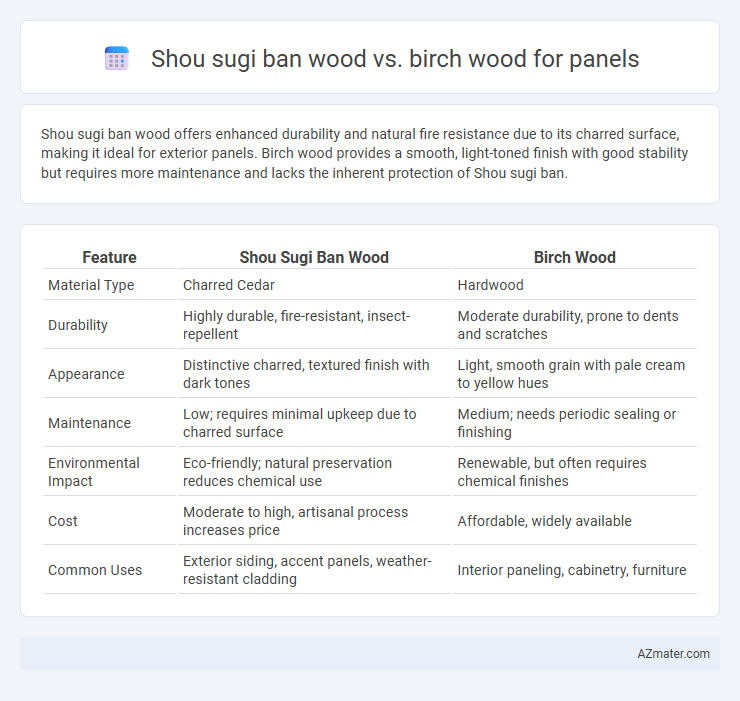Shou sugi ban wood offers enhanced durability and natural fire resistance due to its charred surface, making it ideal for exterior panels. Birch wood provides a smooth, light-toned finish with good stability but requires more maintenance and lacks the inherent protection of Shou sugi ban.
Table of Comparison
| Feature | Shou Sugi Ban Wood | Birch Wood |
|---|---|---|
| Material Type | Charred Cedar | Hardwood |
| Durability | Highly durable, fire-resistant, insect-repellent | Moderate durability, prone to dents and scratches |
| Appearance | Distinctive charred, textured finish with dark tones | Light, smooth grain with pale cream to yellow hues |
| Maintenance | Low; requires minimal upkeep due to charred surface | Medium; needs periodic sealing or finishing |
| Environmental Impact | Eco-friendly; natural preservation reduces chemical use | Renewable, but often requires chemical finishes |
| Cost | Moderate to high, artisanal process increases price | Affordable, widely available |
| Common Uses | Exterior siding, accent panels, weather-resistant cladding | Interior paneling, cabinetry, furniture |
Introduction to Shou Sugi Ban and Birch Wood
Shou Sugi Ban is a traditional Japanese technique that preserves wood by charring its surface, enhancing durability, water resistance, and insect repellence, making it ideal for exterior panels. Birch wood, known for its fine grain and light color, offers a smooth finish and moderate durability but requires sealing to withstand moisture and wear. Both materials provide distinct aesthetic and functional qualities, with Shou Sugi Ban delivering a unique textured, dark appearance and increased lifespan compared to the more delicate and pale-barked birch panels.
Origins and History of Each Wood Type
Shou sugi ban, a Japanese preservation technique dating back to the 18th century, involves charring Yakusugi cedar to enhance durability and resistance to pests. Birch wood, native to northern Europe and North America, has been historically prized for its fine grain and ease of work, commonly used in furniture and paneling since ancient times. While Shou sugi ban emphasizes traditional craftsmanship and longevity through carbonization, birch panels offer a more neutral, light-toned aesthetic with a rich history of woodworking versatility.
Aesthetic Differences: Visual Comparison
Shou sugi ban wood features a distinctive charred surface with deep textures and rich black tones, creating a dramatic, rustic aesthetic ideal for modern and traditional paneling. Birch wood offers a smooth, pale surface with tight grain patterns and warm, creamy hues, lending a clean, bright appearance well-suited for minimalist or Scandinavian designs. The stark contrast between Shou sugi ban's dark, textured finish and Birch's light, sleek look highlights their respective visual appeal for different interior paneling styles.
Durability and Longevity
Shou sugi ban wood, a traditional Japanese technique of charring cedar, offers superior durability and resistance to rot, insects, and fire compared to birch wood, making it ideal for exterior panels. Birch wood, while aesthetically pleasing and affordable, lacks the inherent protective qualities of shou sugi ban-treated wood and is more susceptible to moisture damage and decay over time. Panels made from shou sugi ban wood can last for decades with minimal maintenance, whereas birch panels typically require regular sealing and care to maintain their longevity.
Fire and Weather Resistance
Shou sugi ban wood, a Japanese technique of charring cedar, offers superior fire resistance and weather durability compared to birch wood, which is more susceptible to fire damage and moisture-related deterioration. The carbonized surface of Shou sugi ban creates a protective layer that repels water, resists decay, and reduces flammability. Birch wood panels require regular sealing to withstand weather exposure, while Shou sugi ban panels naturally maintain their integrity under harsh environmental conditions.
Maintenance Requirements
Shou sugi ban wood requires minimal maintenance due to its charred surface, which naturally resists rot, insects, and weather damage, making it ideal for exterior panels. Birch wood panels demand more frequent sealing and protection against moisture and UV exposure to prevent warping, cracking, and decay. Choosing Shou sugi ban reduces long-term upkeep costs and preserves aesthetic appeal with less effort compared to birch wood.
Environmental Impact and Sustainability
Shou sugi ban wood, sourced from Japanese cedar and charred through a traditional technique, offers enhanced durability and natural resistance to pests, reducing the frequency of replacements and chemical treatments, which positively impacts environmental sustainability. Birch wood, commonly harvested from fast-growing deciduous trees, is renewable and biodegradable but often requires chemical finishes for protection, potentially increasing environmental footprint. Choosing shou sugi ban wood for paneling supports longer-lasting, low-maintenance applications with a lower carbon footprint compared to birch, emphasizing sustainable construction practices.
Cost and Availability
Shou sugi ban wood commands a higher price due to its specialized charring process and limited availability, often sourced from select cedar varieties. Birch wood is more widely available and cost-effective, commonly used in paneling for its consistent grain and easy sourcing from multiple regions. The cost difference is significant, with birch panels typically priced lower and more accessible for large-scale projects.
Best Applications for Paneling
Shou sugi ban wood offers exceptional durability and natural resistance to moisture and insects, making it ideal for exterior paneling exposed to harsh weather conditions. Birch wood features a smooth texture and light color, perfect for interior paneling where a clean, modern aesthetic is desired. Both woods serve well in paneling, with Shou sugi ban preferred for rugged, long-lasting applications and Birch suited for elegant indoor finishes.
Final Comparison: Which Wood Is Best for Panels?
Shou sugi ban wood offers exceptional durability, resistance to rot, and a unique charred aesthetic, making it ideal for exterior panels exposed to harsh weather. Birch wood provides a smooth, light finish with good workability but lacks the natural weather resistance and distinctive appearance of shou sugi ban. For long-lasting, low-maintenance panels with a striking visual impact, shou sugi ban wood is the superior choice compared to birch.

Infographic: Shou sugi ban wood vs Birch wood for Panel
 azmater.com
azmater.com